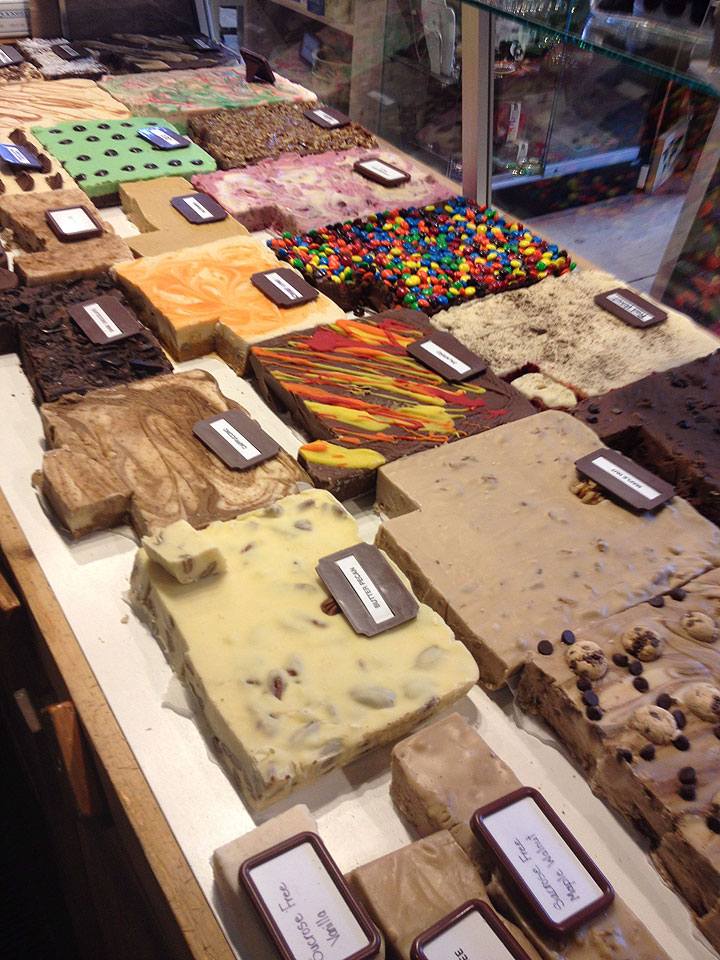LONDON, Ont. – The story goes that fudge was “invented” in the U.S. in the 1880s when someone trying to make another type of candy misjudged the temperature and took it off the stove too soon. They liked the soft, smooth confection that resulted and fudge – and the saying “oh, fudge!” meaning “oops” – were born.

Apocryphal or not, fudge has found a place in the hearts and on the tables of North Americans, especially at this time of year.
“It’s been a tradition for many years,” says Jane Sharrock of Oklahoma City, author of 300 Best Homemade Candy Recipes. “We have usually eaten it around holidays, at times when we had good feelings about what was going on.”
READ MORE: Recipes for maple, chocolate, white cherry and lemon fudge
Marie Swidersky agrees. “We always say fudge is good for you, but we think it’s good for you in that it can make you happy.” She and husband Len sell more than 30 flavours of homemade fudge at outlets of their The Olde Stanton Store in Blue Mountain Village, near Collingwood, Ont., and in the hamlet for which the store was named, about 50 kilometres to the south.
The endless variations of fudge may be another key to its appeal. Sharrock’s book, published by Robert Rose Inc., features 64 fudge recipes, including microwave versions that can be made in five minutes and more complicated creations that take much longer and require serious muscle-power to stir or beat to the correct consistency.
Some have a corn syrup base, while others use marshmallows or marshmallow creme, condensed milk, buttermilk or sour cream. There’s even one made with mashed potatoes and another with cream cheese that requires no cooking.
One constant in many of Sharrock’s fudge recipes is chocolate, although it may be dark, light, white or a combination.
“Traditional fudge is usually made with chocolate. That’s what people here think of when you say fudge.”
But other recipes feature such diverse flavourings as pineapple, apricot, pumpkin, cherry, banana and eggnog.
Vanilla fudge is more common in Canada than in the U.S., and maple-flavoured fudge is a Canadian tradition.
“We do maple fudge and tourists love this, especially from overseas. A lot of them will take it back home” because it’s so typically Canadian, says Kim Cross, manager of The Old Stanton Store at Blue Mountain, where all the fudge is made for both stores.
Although their basic fudge recipes are proprietary, she says they use both chocolate and vanilla fudge bases to make flavours as diverse as jalapeno, carrot cake and cookie dough, as well as more traditional selections. In the summer they make a lemon meringue fudge, and in the fall an apple pie flavour. This year’s seasonal treats include cranberry and candy cane fudge.
Their fudge tables are “a myriad of colours and flavours,” says Swidersky, and on fudge-making days customers can see and smell the process.
They opened the first Olde Stanton Store in 1980 as a gallery for her husband’s artwork but then expanded into gifts and home decor. In 2000, after much thought, they got into the fudge business. Now three of their four adult children are involved in their enterprises.
“We just decided we needed something everybody would enjoy,” she says. “We have taken the mom-at-home fudge, using real cream and butter, but we make gallons of it,” and all visitors to the stores get a free taste.
The product has been so successful that this year they started an online store for fudge, with delivery promised in about a week.
Candy-making at home should not be intimidating or seen as work, says Sharrock. “It should be fun for the cook. It should be fun for the people who eat it.”
But there are a few important rules.
Especially for novice and average cooks, it’s important to follow the recipe to the letter, she says. Most failures occur because cooks try to improvise with ingredients or cooking methods without understanding the complicated “science” of candy-making.
For example, someone who substitutes milk when cream is called for or who doesn’t understand that you start timing when the candy is at a “rolling” or full boil, not just when the first bubbles appear, is doomed to disappointment.
The second requirement is the right equipment – a heavy pot, a good candy thermometer and wooden spoons.
Her favourite pot is an old beat-up cast-iron or cast aluminum pressure cooker base. A stainless-steel pot will “very likely” cause the milk and sugar to scorch.
The final requirement is time. Candy-making is hands-on and demands constant vigilance. You shouldn’t start it unless you have the uninterrupted time to see it through.
“You can’t set it off to the side and expect to come back to it later.”
Sharrock and Swidersky agree fudge shouldn’t be just a holiday tradition.
“While everybody thinks of it as being a special treat for Christmas, people seem to like it even more when you make it outside the holidays,” Sharrock says.
“In this purist society, where everybody tries to eat healthy, people need a little indulgence,” says Swidersky.



Comments